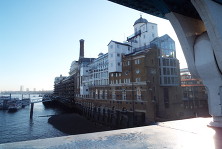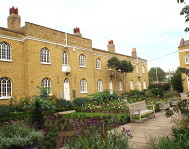








South London Gallery
Today considered to be one of the leading contemporary art spaces in London, the South London Gallery opened in Peckham Road over 120 years ago, one of the philanthropic galleries which were seen to be a means whereby the poor might improve themselves. It has its roots in the South London Working Man’s College that opened in Blackfriars Road in 1868. It moved to a larger building in Kennington Lane in 1878 where a free library was established. In 1879, William Rossiter staged an art exhibition within the library consisting of works borrowed from private collections and artists. The exhibition was only intended to last a short while during the summer months but so many of the loaned paintings were allowed by their owners to remain that the art exhibition became permanent.
The free library and art gallery moved two years later to Battersea and in 1887 to 207 Camberwell Road. The premises were small and the accommodation poor, with no protection against fire and no proper exhibition facilities. Nevertheless, Rossiter felt the Gallery had in it “the germ of a great work” that was doing and could continue to do good work, and should not be stifled at birth. He appealed to Sir Frederick Leighton, Frederick Watts and Edward Burne-Jones who readily gave their time, thought and “help in every way.”
Rossiter bought the freehold to Portland House, Peckham Road. He moved into the house and built the South London Fine Art Gallery in the grounds. It opened in May 1891 displaying changing exhibitions of fine art from a quickly growing collection of works donated both by artists and subscribers to the gallery. In 1893 a new lecture hall and library were opened by the Prince of Wales which had been built with a £3000 donation from John Passmore Edwards. But the subscriptions required to maintain the gallery were not always as forthcoming and Rossiter’s aim was that it become a public art gallery, the National Gallery of South London as a part of the National Gallery or the South Kensington Museums “supported by the nation as a public art gallery and placed where it is most wanted, where the daily lives of the people most are in need of such refreshment, and where the great working classes, whose work beautifies the wealthier parts of the metropolis, live with so little beauty either natural or derived from art.”
The Gallery was very popular and opened on a Sunday which was the only day the working man was able to attend. On some days music was provided and on these days it was estimated 800 people attended in the first hour. But it led to difficulties Rossiter did not foresee. The behaviour of the “better dressed” who believed the gallery was supported by the ratepayers as a public recreation room, where they might eat, smoke, and amuse themselves as they pleased, was believed to keep out the poorer people who, when they saw only a well-dressed crowd, would not believe the gallery was for them. Rossiter introduced the simple device of introducing a compulsory charge for a catalogue for those who looked as if they could afford it. This had the effect of keeping out those who were really not interested in seeing the art as they had no wish to pay for a catalogue.
Camberwell Vestry took over the gallery in 1896 and as a consequence William Rossiter retired and sadly died shortly afterwards. His account of the first 25 years of the South London Working Man's College and the art gallery can be found here.
***
The Passmore Edwards Library and Lecture Hall were badly damaged during the second world war and later demolished. The gallery reopened in 1949 with a series of temporary exhibitions. The gallery had acquired a growing permanent collection, often from artists and collectors who donated those pictures they originally loaned on a temporary basis. In 1951, local artists were commissioned to produce paintings of local scenes, and works by modern British artists of the day were purchased and added to the collection in 1953 to celebrate the Coronation.
A new Director was appointed in 1992 and under his leadership, the gallery redirected its focus to concentrate on contemporary art. This proved a shot in the arm for the gallery, now called South London Gallery, and its profile and visitor figures increased dramatically as it began to stage exhibitions by internationally acclaimed artists such as Gilbert & George, Anselm Kiefer and Sherrie Levine, as well as younger artists such as Tracey Emin, Gavin Turk and Ann Sofi-Sidén. In 2003 the gallery became independent of Southwark Council to become a charitable trust with a grant from the Arts Council who also agreed a tenfold increase in funding. Southwark Council have also continued to fund the gallery and they now manage the gallery’s permanent collection which forms the basis of the Southwark Art Collection.
http://www.southlondongallery.org/
South London Gallery in Peckham Road. The house to the right was derelict until 2010 when the gallery acquired it. It now houses a cafe, additional galleries and a bookshop.
Web discoveries
- UK Casino Not On Gamstop
- UK Casino Not On Gamstop
- Non Gamstop Casino
- Casinos Not On Gamstop
- Non Gamstop Casinos
- Non Gamstop Casinos
- Non Gamstop Casino
- Casino Sites Not On Gamstop
- Slots Not On Gamstop
- Casinos Not On Gamstop
- UK Betting Sites Not On Gamstop
- UK Casino Not On Gamstop
- Best Non Gamstop Casinos
- Betting Sites
- Non Gamstop Casino Sites UK
- Best Non Gamstop Casinos
- Non Gamstop Casino
- Casinos Not On Gamstop
- Non Gamstop Casino Sites UK